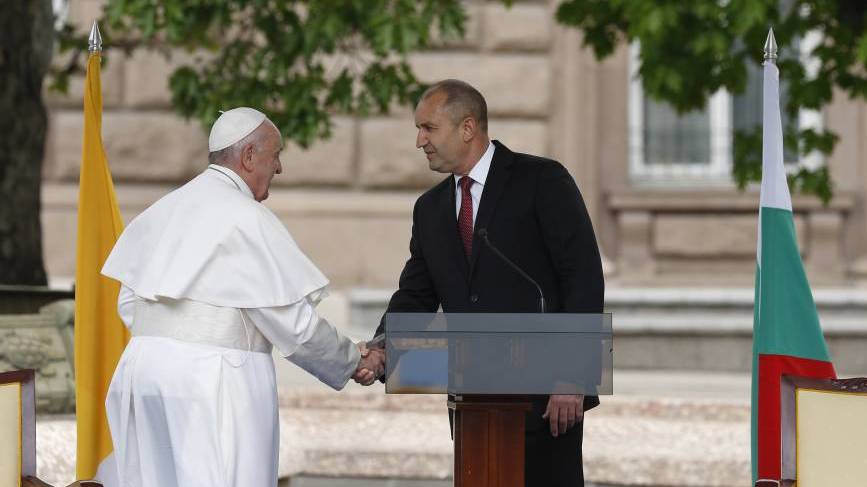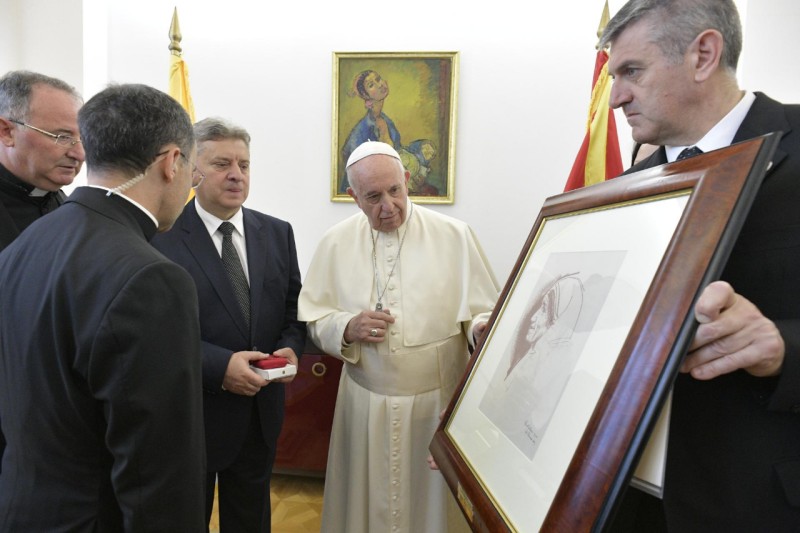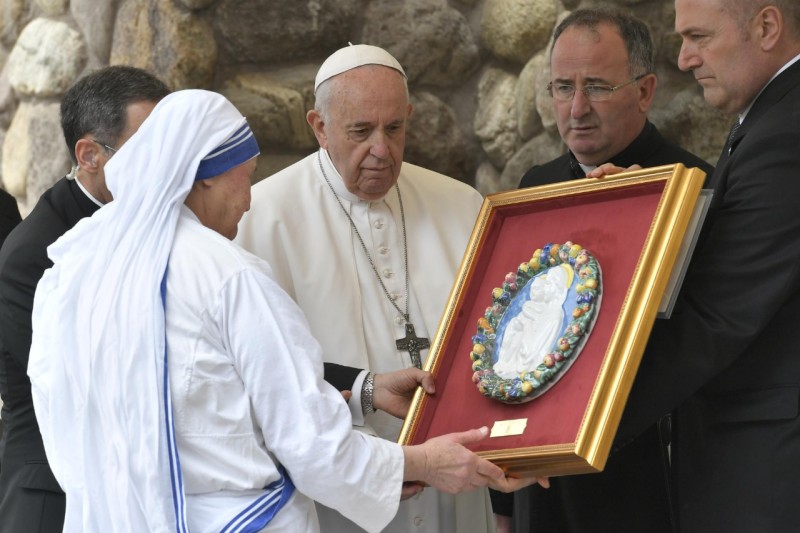SEARCH

Here are the details of gifts given by Pope Francis during his Apostolic Journey to Bulgaria and North Macedonia. Text courtesy of the Holy See Press Office.Reproduction of the Vatican Secret Archive circa Saint John XXIII. Gift offered to the President of the Republic. The Vatican Secret Archive has produced on parchment the Brief appointing H.E. Msgr. Angelo Roncalli as Apostolic Delegate to the Kingdom of Bulgaria (Brief of 16 October 1931). Indeed, Roncalli was the first Apostolic Delegate of Bulgaria since in 1925, Pope Pius XI had appointed him as Apostolic Visitor to the country with the task, above all, of tending to the grave needs of the small Catholic community. The initial term was transformed into a ten-year tenure, during which Roncalli laid the foundations for the foundation of an Apostolic Delegation, where he held the post until 1934. The same Archive has also produced a duplicate of a particular photograph in which H.E. Msgr. Roncalli is surrounded by the Catholic and especially Orthodox clergy in Sofia in 1934, on the reverse of which the future John XXIII wrote: Priests and bishops of Oriental rite. Primary concern of the Apostolic Delegate. Codex Pauli. Gift offered to the Patriarch. Edited to commemorate two millennia since the birth of Saint Paul, it is a single volume of 424 pages, enriched with a minutely-detailed selection of friezes, frames, miniatures and illustrations from manuscripts dating from different periods from the Abbey of Saint Paul Outside-the-Walls, in particular the Carolingian Bible, conserved for more than a thousand years buy the Benedictine monks. The cover, encased in smooth suede calfskin, is decorated with eight bronze forms inspired by the Byzantine Door of the Basilica of Saint Paul Outside-the-Walls, with on the front cover scenes of the mysteries of the life of Christ and on the back cover, of the life of the nascent Church. The eight corners are decorated with the sword, typical symbol of Pauline iconography. Triptych in wood with Madonna and Angels. Gift offered to the Franciscan Sisters of Rakovski. Produced by the Monastic Fraternity of Bethlehem during the pontificate of Pope Paul VI, this elegant banded triptych is an altarpiece for domestic prayer. The external strips present the figures of St. Paul of Tarsus, the apostle of the Gentiles, and of St. John the Baptist, the precursor of Christ; while in the inner section we find two praying angels with their heads bowed towards the representation of the Virgin Mary, who became the “living tabernacle” of Our Lord, also with open arms and in a praying position. Before the Virgin Mary there is also a representation, as in a large host, the main theme of this triptych: the Most Holy Trinity according to the Orthodox Russian Church, drawn from a celebrated 1422 icon of the iconographer saint Andrej Rublëv, now conserved in the Tret'jakov Gallery of Moscow. Here Rublëv, to represent the synthesis of the greatest mystery of our faith and to reveal to us at the same time both unity and the distinction of the divine Persons, chose the circle (eternity, perfection) as the dominant motif of the entire composition, in which he inserted perfectly three angelic figures, entirely similar in appearance and seated around a table, which seem to indicate that perfect love without beginning and without end. This scene, that does not seem to represent the Trinity, however derives from the book of Genesis, where it is recounted that Abraham receives three strangers in his tent (Genesis 18: 1-8). This polyptych, then, through its complex symbolism, not only summarizes the theological positions of the Most Holy Trinity according to the rigid guidelines of the Church, but underlines the very nature of God through the use of the three angels, made of “pure spirit”. Icon of Our Lady. Gift offered to the “Vrazhdebna” Refugee Camp. This elegant icon of the Virgin Mary with Child was produced, using ancient artisanal techniques from Byzantine Christian culture. This subject was not chosen by chance, given that in order to make Himself man Jesus was incarnated in the Virgin Mary, who prodigiously became a “living tabernacle”, protected by Saint Joseph, who in chastity and obedience watched over mother and child as a spouse and putative father, so that He “grew in wisdom and stature, and in favour with God and man” (Lk 2: 51-52), until His first public appearance on the banks of the Jordan, where, recognized by John, He received baptism and began His preaching, as is narrated in the Gospels of Mark (1: 9-11), Matthew (3: 13-17) and Luke (3: 21-22). On closer inspection, however, the aureole of the Child presents the typical Greek letters that refer to the statement: “I am Alpha and Omega, the beginning and the end, the first and the last” (Rev 22, 13-21). In this sense, therefore, the presence of this holy icon in a place of prayer, as well as in a domestic place, serves as a warning to the good Christian, so that he may live the “sanctity of daily life”: a subject so dear to Pope Francis, who dedicated his third Apostolic Exhortation, entitled “Gaudete et Exsultate”, to this theme. It is in the ordinary way of living the ordinary Christian existence within the family, in fact, that one can experience the “sanctity of everyday life”, which is not for a few heroes or exceptional people, but for those “parents who raise their children with immense love, in those men and women who work hard to support their families, in the sick, in elderly religious who never lose their smile” (7). Mosaic of the Coat of Arms of Pope Francis. Gift offered to the Apostolic Nunciature. Entirely produced in mosaic with the traditional system of manual cutting and setting of the coloured tesserae, this panel depicts the coat of arms of His Holiness Pope Francis. The papal coat of arms consists of, at the top, the symbol of the Society of Jesus. It is composed of a radiant and flaming sun, in which there is the acronym IHS, and above, a cross with three nails at the base. The acronym IHS lends itself to interpretation as Iesus Hominum Salvator (Jesus, Saviour of Humanity), or In Hoc Signo (Vinces), of Constantinian memory; whereas subsequently the Jesuits interpreted it as Habemus Iesum Socium (We have Jesus as Companion) and Societas Iesu humilis (Humble Society of Jesus). Aside from the symbol of the Society of Jesus, there also appear a star, which according to the heraldic tradition symbolizes the Virgin Mary, and the spikenard flower, which in Hispanic iconography refers to the chastity of Saint Joseph. By placing these symbols on his coat of arms, Pope Francis therefore wished to express not only his particular devotion to the Most Holy Name of Jesus and his membership of the Jesuits, but also his devotion to the Virgin Mary and to Saint Joseph, her spouse. Instead the motto accompanying the pontifical coat of arms of Pope Francis – Miserando atque eligendo – is instead a homage to divine mercy. It is taken from the Homilies of Saint Bede the Venerable, who in commenting on the Gospel episode of the vocation of Saint Matthew, wrote: Vidit ergo Iesus publicanum et quia miserando atque eligendo vidit, ait illi Sequere me (Jesus saw a tax collector and, as he looked at him with sentiment of love and chose him, He said to him: Follow me).

